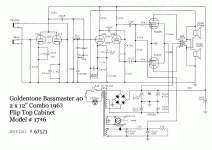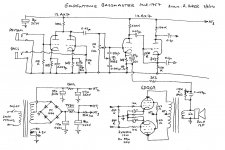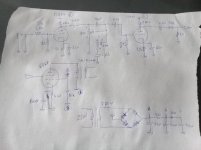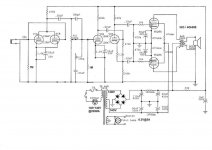Hi to all! I am looking for a 15 to 20 w single ended amp. So my doubt is wha tube is the best option? 6dq6b or 6l6gc or another?
Neither will give you 15-20W SE IMHO. You can get 20W SE out of KT120 though. Possibly EL509, too.
Sorry, you're not going to get 15 honest W. out of either type. The 6L6GC is the more capable type and its plate is rated for 30 W. Real world Class "A" efficiency is < 50%.
A full pentode or UL mode KT88 is what you need.
A full pentode or UL mode KT88 is what you need.
Good Sunday,
I hope this helps.....
That appears to be a bass guitar amp. So this begs the question, is the OP building a hifi or guitar amp?
jeff
That appears to be a bass guitar amp. So this begs the question, is the OP building a hifi or guitar amp?
jeff
The initial idea is to make an amplifier like the mathcless spitifire but with more power. the pre circuit would be the same as the original, a 12ax7 with its triodes in parallel and another 12ax7 as a phase inverter. the modification would be in the power. the spitifire uses a pair of el84 in pp, I could use 4 el84 in ppp to get 30w but it would be very expensive for me. Can the spitifire pre handle a pair of 6dq6 in pp?
You could build this (connected as tetrode with regulated screen voltage) and it'll give you 25W.
Tubes are pretty cheap, too.
6F12P and 6P43P push pull triode amp
Tubes are pretty cheap, too.
6F12P and 6P43P push pull triode amp
Two options,
1. Glass Audio magazine volume 7, number 6, 1995. The 6dq5 single ended power amp. The author got 14w from a single 6dq5 in pentode mode.
Operating conditions were plate supply = 200v, grid bias = -25v, load resistance = 1.6k, plate dissipation = 24w.
2. Adapt the RH amplifier concept for a 6dq5 or parallel 6dq6, 6cd6, or many other sweep tubes.
You can find info here: RH Amplifiers
For more sweep tubes: "Complete" list of sweep tubes
1. Glass Audio magazine volume 7, number 6, 1995. The 6dq5 single ended power amp. The author got 14w from a single 6dq5 in pentode mode.
Operating conditions were plate supply = 200v, grid bias = -25v, load resistance = 1.6k, plate dissipation = 24w.
2. Adapt the RH amplifier concept for a 6dq5 or parallel 6dq6, 6cd6, or many other sweep tubes.
You can find info here: RH Amplifiers
For more sweep tubes: "Complete" list of sweep tubes
Take into account the output transformer loss.
Consider an output transformer that has 1 dB insertion loss:
12.58 Watts in = 10 Watts out.
Some people find it hard to tell a 1 dB sound level difference.
The old Hi Fi rule was, if you want more power, then purchase an amplifier that has 3 dB more power (Have 10 Watts, move up to 20 Watts).
Consider an output transformer that has 1 dB insertion loss:
12.58 Watts in = 10 Watts out.
Some people find it hard to tell a 1 dB sound level difference.
The old Hi Fi rule was, if you want more power, then purchase an amplifier that has 3 dB more power (Have 10 Watts, move up to 20 Watts).
Hi to all! I am looking for a 15 to 20 w single ended amp......The initial idea is to make an amplifier like the mathcless spitifire but with more power........12ax7 as a phase inverter.
First you ask about a single ended amp, then the idea is to make a bigger spitfire, which is a push pull amp. Then you like a push pull amp's output stage, but wonder if the spitfire's preamp can drive it.
Not sure which question you want the answer to, but neither the 6L6GC or the 6DQ6 can make 15 to 20 watts in a single ended configuration.
Two of either in push pull can do far more than 20 watts. 50 watts from a pair of 6L6GC's is doable, and 75 watts from a pair of 6DQ6's isn't hard......but the spitfire preamp hasn't got enough gain to do the job with either tube set.
The spitfire uses 6BQ5 / EL84's which is an easy tube to drive. The 6L6GC will need about double the drive to get into the 30 to 50 watt zone, and the 6DQ6 needs more than that.
You will need another stage of gain to get enough drive voltage. Either of those tubes will work from 360 to 450 volts depending on what your OPT impedance is. That will require a power transformer in the 300-0-300 to 360-0-360 volt range.
thank you. Yes, I understand the mess of my questions. What I really want is a 20w spitifire. if I could do it with a 6dq6b in it would be great.
Transformers often cost more than tubes. Transformers for "odd" tubes are sure to cost more than trans for "normal" tubes.
The sweep/RF tubes 6146 and 6DQ6, when used for SE audio, really want Vg2 way below Vp. Since Ig2 varies with drive, this means a separate supply just for G2. The plan in #12 requires a CT on the HV winding which is an uncommon voltage (maybe: it could be 240VCT implemented as 120V+120V, a mains transformer from control equipment).
The "for audio" tubes are bent for Vg2 similar to Vp to avoid supply complication. 6L6 is a classic AND you can get a replacement on the road on a Saturday night. 807 is "the same tube" (kinda) but the top-cap is lethal and a true 807 has a funny base.
Use 6L6 with readily available "super 6L6 Champ" iron (10-15W 80mA 4k) and accept the power you get, probably 10 Watts. This is not a big drop from 20 Watts. If you play larger rooms, you want to mike into the PA system anyway, so amp power is not critical. If you must play the big stadiums withOUT a PA system, *go push pull* (and don't go cheap).
The sweep/RF tubes 6146 and 6DQ6, when used for SE audio, really want Vg2 way below Vp. Since Ig2 varies with drive, this means a separate supply just for G2. The plan in #12 requires a CT on the HV winding which is an uncommon voltage (maybe: it could be 240VCT implemented as 120V+120V, a mains transformer from control equipment).
The "for audio" tubes are bent for Vg2 similar to Vp to avoid supply complication. 6L6 is a classic AND you can get a replacement on the road on a Saturday night. 807 is "the same tube" (kinda) but the top-cap is lethal and a true 807 has a funny base.
Use 6L6 with readily available "super 6L6 Champ" iron (10-15W 80mA 4k) and accept the power you get, probably 10 Watts. This is not a big drop from 20 Watts. If you play larger rooms, you want to mike into the PA system anyway, so amp power is not critical. If you must play the big stadiums withOUT a PA system, *go push pull* (and don't go cheap).
Some Australian guitar amps designed around sweep tubes used a voltage-doubler power supply, which conveniently also generates a half-B+ voltage, which was used for the screen grid bias.The plan in #12 requires a CT on the HV winding...
I am confused by the OP's requirement for more power (20 W), along with a less-efficient mode of operation (class A), along with sonic similarity to a PP Matchless Spitfire. In my experience, single-ended amps tend to sound quite different than PP amps, both for clean tones, and particularly when overdriven. And a 20W SE amp would be a heavy, power-sucking monster to boot.
20 watts from a Matchless-like design does seem to be quite possible. Wikipedia has this to say about the EL84 tubes in the Matchless Spitfire:
So it looks like the OP could have his cake and eat it too - use a pair of EL84s in push-pull just like the Spitfire does, borrow the power supply design from the Traynor Guitarmate, and get even more than the 20 watts he wants."It (i.e. the EL84) can produce 17 W output in Class AB1 in push–pull configuration. Many guitar amplifiers routinely run EL84 tubes in excess of 400 VDC, with the Traynor Guitarmate reportedly putting out 25 W RMS with 2 EL84s in a push–pull configuration and a B+ between 400–420 VDC."
I haven't studied the Traynor Guitarmate schematic at all, but this seems like the simplest route, as well as the one most likely to sound like a 25W Spitfire, as the only real modification is the B+ and maybe bias voltages to the output pair.
-Gnobuddy
Last edited:
Many guitar amplifiers routinely run EL84 tubes in excess of 400 VDC, with the Traynor Guitarmate reportedly putting out 25 W RMS with 2 EL84s in a push–pull configuration and a B+ between 400–420 VDC."
I have seen 30 watts from a pair of EL84's in a HiFi amp. B+ was 430 volts, screen was regulated at 320 volts and the OPT was 6600 ohms. Only JJ EL34's and some NOS 6BQ5's would eat this voltage without red plate, glowing screen, or both.
Thanks for the reply. I desist for the SE o EL84 pp idea. Im working on this desing now.
I don't see any obvious faults and it should make plenty of power, even more with a real 4 ohm load on that OPT. I would use a 50 or 63 volt cap for the cathode bypass cap on those 6DQ6's. They tend to need a lot of bias voltage.
I don't see any obvious faults and it should make plenty of power, even more with a real 4 ohm load on that OPT. I would use a 50 or 63 volt cap for the cathode bypass cap on those 6DQ6's. They tend to need a lot of bias voltage.
Thanks! My only doubt are the spesifications of the power and output transformers. They are PT A&R 5236 and OT A&R 2680
if the plate works at 300v and the screen at 150v them a 115v + 115v is good PT choise? (230x1.44=335v and 115x1.44=165v)
Last edited:
- Home
- Live Sound
- Instruments and Amps
- 6dq6 or 6l6gc se amp?



